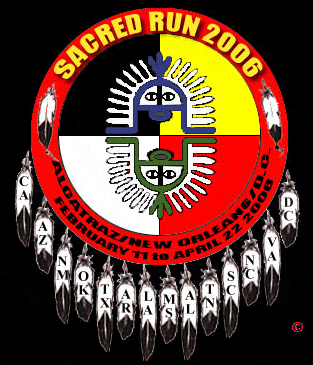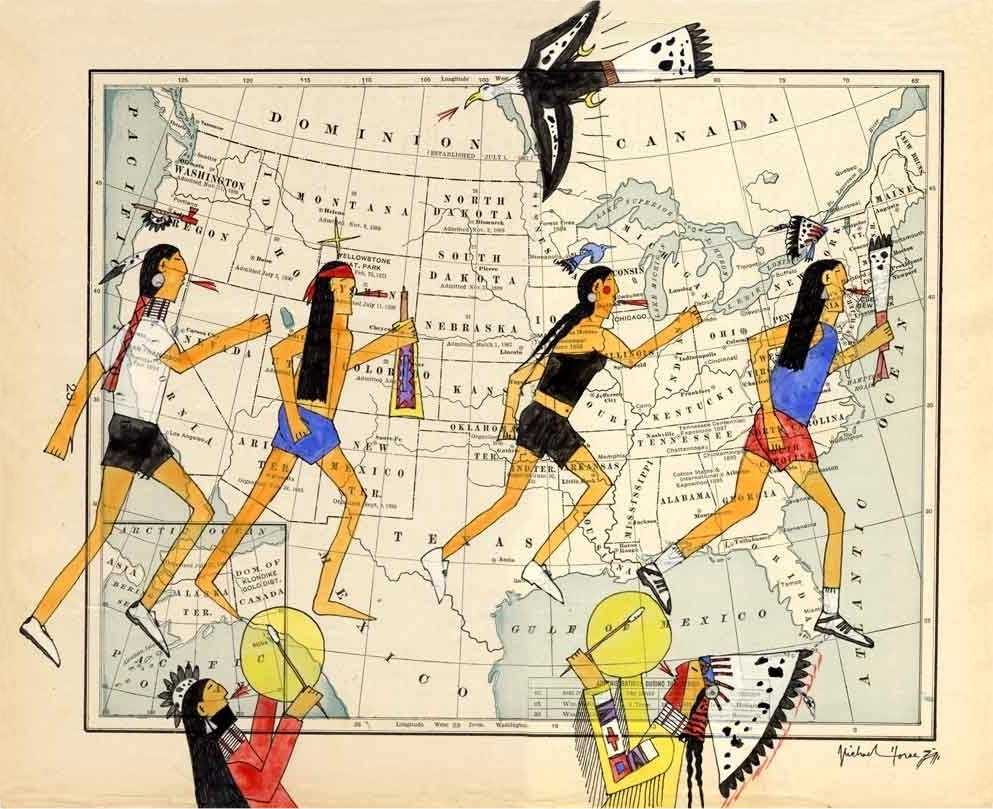Day
52 - Monday, April 3, 2006
Choctaw Nation, Philadelphia, Mississippi
A
Day in the Life of a Sacred Runner
by Robert Richardson (Tree)
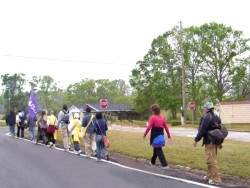 Sunday,
April 2nd, 2006, the 51st day of the Sacred
Run began warm and humid in the heart of
Mississippi, on the land of the Choctaw Nation,
outside a little town called Philadelphia.
Breakfast is prepared and delivered to us
in camp, every detail seen to by representatives
of the Choctaw People. They left nothing
out of the gourmet, camp style feast that
included hot steaming grits, butter and honey,
smoked ham, Italian sausage, scrambled eggs,
fresh fruit, milk, juice and hot coffee.
We all sat and ate in a semi circle, a natural
position that everyone informally gravitates
towards. It occurs to me that this is out
of respect for each other, no one is left
out, no one is more or less important than
the other.
Sunday,
April 2nd, 2006, the 51st day of the Sacred
Run began warm and humid in the heart of
Mississippi, on the land of the Choctaw Nation,
outside a little town called Philadelphia.
Breakfast is prepared and delivered to us
in camp, every detail seen to by representatives
of the Choctaw People. They left nothing
out of the gourmet, camp style feast that
included hot steaming grits, butter and honey,
smoked ham, Italian sausage, scrambled eggs,
fresh fruit, milk, juice and hot coffee.
We all sat and ate in a semi circle, a natural
position that everyone informally gravitates
towards. It occurs to me that this is out
of respect for each other, no one is left
out, no one is more or less important than
the other.
 Our
hosts see to every detail, making sure everyone
has had enough before breaking down the tables
and giving us a schedule for the days events
planned.
Our
hosts see to every detail, making sure everyone
has had enough before breaking down the tables
and giving us a schedule for the days events
planned.
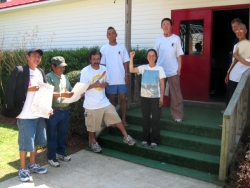 We
have a few hours for laundry, rest, reading
or leisure, but at 2:00pm the Choctaw Stickball
game would begin in the Football stadium,
across from the amphitheater.
We
have a few hours for laundry, rest, reading
or leisure, but at 2:00pm the Choctaw Stickball
game would begin in the Football stadium,
across from the amphitheater.
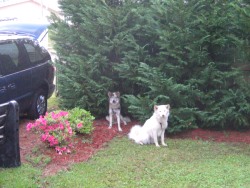 The
morning hours are whiled away, runners and
walkers tending to nursing aches and pains,
or reading out in the warm sun, or napping
on the fresh cut grass of the theater arena.
Jun-San and Itchi-San offer advice and assistance
to anyone who requests it. The mood is quiet,
thoughtful, respectful.
The
morning hours are whiled away, runners and
walkers tending to nursing aches and pains,
or reading out in the warm sun, or napping
on the fresh cut grass of the theater arena.
Jun-San and Itchi-San offer advice and assistance
to anyone who requests it. The mood is quiet,
thoughtful, respectful.
Lunch time is announced by the aroma of
stir fry vegetables, rice and miso soup drifting
across the courtyard from the compound kitchen,
courtesy of Jun-San, Itchi-San, Eri-San,
and Itsuko-San, the Japanese women who lead
the chants and tap out the cadence of the
drums of each mile walked.
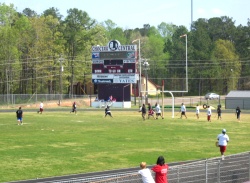 After
lunch, we hear the loudspeaker from across
the amphitheater that the Stickball game
would soon begin. Soon all the members of
the Sacred Run are walking the short distance
to the stadium. As we enter the stadium,
the loudspeaker announces our arrival, and
the people already assembled there, spectators
and players alike, all welcome us with a
warm applause.
After
lunch, we hear the loudspeaker from across
the amphitheater that the Stickball game
would soon begin. Soon all the members of
the Sacred Run are walking the short distance
to the stadium. As we enter the stadium,
the loudspeaker announces our arrival, and
the people already assembled there, spectators
and players alike, all welcome us with a
warm applause.
The event begins with an explanation of
the game. Stickball is an ancient sport played
since the beginning memories of the Choctaw
People. Choctaw Stickball is believed to
be the oldest sport played on the continent.
It is the sport that spawned many other types
of similar ball games including Lacrosse.
The physical strength, endurance and skill
to play Choctaw Stickball is comparable to
any Olympic sporting competition known today.
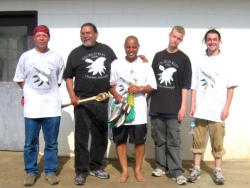 The
first few rounds are played by just Choctaw
athletes, uniformed in black or gray shirts,
all with matching Sacred Run insignias. But
there was one more special touch given to
the jerseys by the Choctaw; the profile of
an Eagle above the Sacred Run design.
The
first few rounds are played by just Choctaw
athletes, uniformed in black or gray shirts,
all with matching Sacred Run insignias. But
there was one more special touch given to
the jerseys by the Choctaw; the profile of
an Eagle above the Sacred Run design.
Dennis Banks himself was outfitted with
one of the beautiful jerseys, and two ‘sticks’,
handcrafted of Hickory wood, right here on
the Choctaw Nation lands, just as they have
been for centuries. Dennis, whose 76th birthday
is April 12th, did a fine job, despite the
heat, of defending the goal for the men in
black. After a half hour though, he called
for help from the Sacred Runners. So, Kid
Valance, Nuno Caetano, Sean Tucker, Jamie
Gorman, and Larry Bringing Good (not
in this picture) ran down and donned
the special ‘Sacred Run’ jerseys,
and took to the field, sticks in hand.
 They
all got right in there, running and jockeying
for the ball with the best of them. Kid,
who ran the length of the field as many times
as anyone, was called for the only penalty
of the day when he picked up the ball in
his bare hands and tried to run with it.
He tried to explain his action later, by
saying, “they were yelling at me to
pick it up, and using those sticks was like
trying to eat soup with a fork, so I just
picked it up and ran with it!” He honestly
thought it was alright to do that, but as
he now knows – your hands can be beaten
to hamburger by the other players if you
are holding the ball!
They
all got right in there, running and jockeying
for the ball with the best of them. Kid,
who ran the length of the field as many times
as anyone, was called for the only penalty
of the day when he picked up the ball in
his bare hands and tried to run with it.
He tried to explain his action later, by
saying, “they were yelling at me to
pick it up, and using those sticks was like
trying to eat soup with a fork, so I just
picked it up and ran with it!” He honestly
thought it was alright to do that, but as
he now knows – your hands can be beaten
to hamburger by the other players if you
are holding the ball!
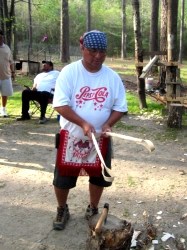 After
Stickball, everyone went back to the amphitheater,
and readied themselves for the big feast
being prepared for us in Bogue Chitto, a
small town just east of us here in Philadelphia,
MS. At the appointed time, the caravan took
us to the home of one of the families of
the Choctaw People. This was the place where
the food was being cooked, but also, it was
the place where the sticks were made for
Choctaw stickball, and we were given a short
tutoring of how it is done, according to
the traditions of the Choctaw People.
After
Stickball, everyone went back to the amphitheater,
and readied themselves for the big feast
being prepared for us in Bogue Chitto, a
small town just east of us here in Philadelphia,
MS. At the appointed time, the caravan took
us to the home of one of the families of
the Choctaw People. This was the place where
the food was being cooked, but also, it was
the place where the sticks were made for
Choctaw stickball, and we were given a short
tutoring of how it is done, according to
the traditions of the Choctaw People.
There was a small workshop outdoors under
the tall pines, where they had everything
needed to make the perfect stickball sticks.
They showed us how they cut, split and shape
the Hickory. They showed us how they tanned
and stripped the deer hide for the stick
netting, carefully shaping the stick, and
then forming the deerskin for just the right
cup. Then we saw how they detailed the difference
between left and right handed sticks, and
the minor differences between the two sticks,
one for passing or shooting the ball, the
other a smaller cup to help scoop the ball
into the other.
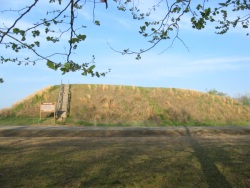 Soon
we were back in the caravan, heading to a
very sacred location for the Choctaw, the
Nanih Wayia Mound, just outside of Bogue
Chitto. The vans pulled up, and we were all
immediately impressed with a feeling of reverence.
The mound rose up from a nearly flat plain
that was clear of any trees except the distant
windrows of oaks and sweetgum. Behind us,
the cypress stood tall in the murky, mossy
swamp, like dark, ageless sentinels standing
guard over the silent Mound, the Mother of
the Choctaw People.
Soon
we were back in the caravan, heading to a
very sacred location for the Choctaw, the
Nanih Wayia Mound, just outside of Bogue
Chitto. The vans pulled up, and we were all
immediately impressed with a feeling of reverence.
The mound rose up from a nearly flat plain
that was clear of any trees except the distant
windrows of oaks and sweetgum. Behind us,
the cypress stood tall in the murky, mossy
swamp, like dark, ageless sentinels standing
guard over the silent Mound, the Mother of
the Choctaw People.
The feeling of reverence just intensified
as I realized how sacred the ground beneath
my feet actually was. The Mother Mound was
built over one thousand years ago. It was
the center point for the civilization that
spread around it. It is not a large mound,
perhaps 100 feet high, 200 feet long at its
widest point, elongated in an oval, almost
kidney shape, but quite immense when one
computes the effort it must have taken to
construct.
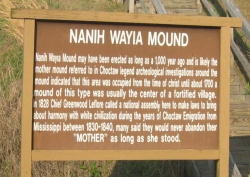 We
walked silently as we approached the large
sign that told the story of the Mound, its
history, and its sacredness to the Choctaw
People. It is known as the Mother Mound,
because it is thought to be the same mound
described in Choctaw legends and lore, as
a major part of the Choctaw People’s
creation, a story passed down from the earliest
memories of the Choctaw. This mound has stood
silent for centuries, holding within it the
memory of the origin of this tribe.
We
walked silently as we approached the large
sign that told the story of the Mound, its
history, and its sacredness to the Choctaw
People. It is known as the Mother Mound,
because it is thought to be the same mound
described in Choctaw legends and lore, as
a major part of the Choctaw People’s
creation, a story passed down from the earliest
memories of the Choctaw. This mound has stood
silent for centuries, holding within it the
memory of the origin of this tribe.
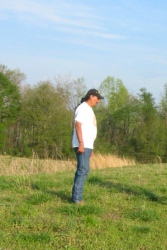 We
read the sign in silence, the feeling of
its sacredness filling our senses. Slowly
we filed up the steps to stand above the
rolling fields, where Dennis Banks and Ron
Alex made an offering of food, water and
tobacco.
We
read the sign in silence, the feeling of
its sacredness filling our senses. Slowly
we filed up the steps to stand above the
rolling fields, where Dennis Banks and Ron
Alex made an offering of food, water and
tobacco.
I imagined the people who built this mound,
how they put it close to the stream, and
wondered if it had been a special point to
be overlooking the stream, while the panorama
on the other side went for miles. Even with
only a slight elevation, we could see very
far.
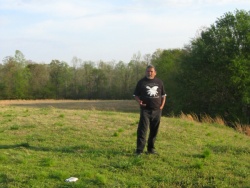 As
we stood in silence, the warm breeze in our
hair, the sun on our faces, we listened as
Dennis spoke to us about the sacredness of
this place. He talked about the Choctaw history,
about the legends, occasionally asking Ron,
our guide, for details, wanting to be accurate
in his understanding of this sacred place.
As
we stood in silence, the warm breeze in our
hair, the sun on our faces, we listened as
Dennis spoke to us about the sacredness of
this place. He talked about the Choctaw history,
about the legends, occasionally asking Ron,
our guide, for details, wanting to be accurate
in his understanding of this sacred place.
He then told us of an experience he had
where he was called in to help rededicate
a sacred site, a very sad case in California,
at the Slack Ranch, where thieves were using
metal detectors to locate the individual
graves for the purpose of making money from
the artifacts buried there. By the time they
were stopped, they had located and were in
the process of desecrating nearly 1,200 graves.
Once located, they shoveled away the dirt
exposing pottery, jewelry, ornaments and
bones. The items were being taken and ‘legally’ sold
on E-bay. Items being sold included burial
vessels that contained the small bodies of
children who died young or at birth. Dennis’ words
struck deeply, as we stood atop Nanih Wayia
Mound. As he described the scene at Slack
Ranch in California, perhaps where we stood
magnified the reality of the desecration,
the degradation of the ancestors, the defiling
of what is sacred.
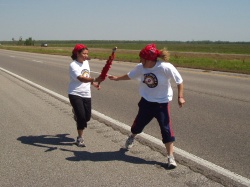 Then
Dennis challenged each on of us, that to
be Sacred Runners we must believe in sacredness,
defend what is sacred, stand up and fight
for it, because if we don’t, then no
one will. If no one defends what is sacred,
then sacredness itself will disappear entirely.
Then
Dennis challenged each on of us, that to
be Sacred Runners we must believe in sacredness,
defend what is sacred, stand up and fight
for it, because if we don’t, then no
one will. If no one defends what is sacred,
then sacredness itself will disappear entirely.
Dennis went on to remind us that to be a
Sacred Runner, we have to realize, the message
does not stop in Washington. It begins there,
and from there he admonished us to be ready.
As Sacred Runners, we have to be ready at
all times to defend what is sacred. As Sacred
Runners, it is a commitment for life.
As the wind caressed our faces, the warmth
of the sun on our skin, Dennis’ words
opened our minds, reached in and planted
the seed, or nurtured the already growing
faith that all life is sacred, we are all
related, and our mission is truly necessary,
though it is a burden upon our shoulders,
it is a task given to us by the Creator,
and now, we have accepted it, this is what
we have chosen. We must see this burden as
a blessing; take it in our hearts as our
personal appointment directly from the Creator.
Without calling for it, we held a moment
of silence, each of us deep in thought, committing
or recommitting to Creator, to take that
appointment willingly, and completely.
We slowly, hesitatingly, returned down the
steps, to the vans, but still in deep in
thought, more committed than ever to bringing
the message of Life, Land and Peace to as
many as we can touch, as well as rededicating
ourselves to protecting and defending all
that is Sacred, all places, ceremonies, traditions,
and all life.
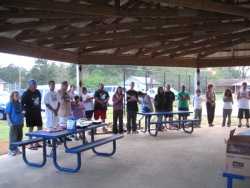 We
returned to the Bogue Chitto for yet another
feast prepared for us by the Choctaw peoples,
our gracious hosts. Their banquet was a heartfelt
thanks to the sacred Runners and Dennis Banks,
long time friends of the Choctaw People.
We
returned to the Bogue Chitto for yet another
feast prepared for us by the Choctaw peoples,
our gracious hosts. Their banquet was a heartfelt
thanks to the sacred Runners and Dennis Banks,
long time friends of the Choctaw People.
After the prayers and honors were given,
everyone feasted on a great meal of chicken,
beans, cornbread, fry bread, all kinds of
vegetables cooked in different ways, and
a desert tray that covered an entire picnic
table all by itself.
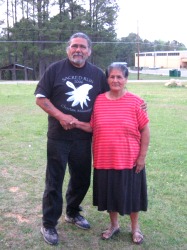 Once
again, the Choctaw did a wonderful job of
making each of us feel welcomed, loved and
appreciated. After the meal, songs were sung
by the Choctaw Elders. There was much handshaking,
hugging, and tears of gratitude from the
Sacred Runners as well as the hosts, the
gracious Choctaw People. One young man, Elijah
Jimmie, came forward to me, and thanked me
for my tree planting. Of course we offered
him some of our acorns, and with love in
our hearts we dedicated these trees to the
Choctaw. A special thanks to Elijah, from
my wife and myself, to you and your wife,
for loving trees as we do, Yakoki!
Once
again, the Choctaw did a wonderful job of
making each of us feel welcomed, loved and
appreciated. After the meal, songs were sung
by the Choctaw Elders. There was much handshaking,
hugging, and tears of gratitude from the
Sacred Runners as well as the hosts, the
gracious Choctaw People. One young man, Elijah
Jimmie, came forward to me, and thanked me
for my tree planting. Of course we offered
him some of our acorns, and with love in
our hearts we dedicated these trees to the
Choctaw. A special thanks to Elijah, from
my wife and myself, to you and your wife,
for loving trees as we do, Yakoki!
After the formal ceremony and feasting,
a round of gifting took place as the children
began to scatter. T-shirts were given to
each runner and walker, presented one at
a time, photographed, and applauded, again
honoring the Sacred Run for its sacrifice
and its purpose, 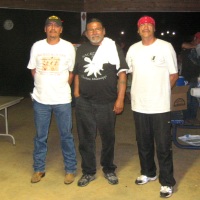 so
needed in this tumultuous world. A unity,
an unbreakable bond, obviously exists here,
a feeling unique only to these Native People,
who are brothers and sisters, regardless
of tribal affiliations, they are and will
always remain brothers and sisters – the
manifestation of their core belief - We Are
All Related!
so
needed in this tumultuous world. A unity,
an unbreakable bond, obviously exists here,
a feeling unique only to these Native People,
who are brothers and sisters, regardless
of tribal affiliations, they are and will
always remain brothers and sisters – the
manifestation of their core belief - We Are
All Related!
Finally after much talking and laughing,
the goodbyes came, and the group then headed
back to the Tribal Headquarters, and the
camp area. A sweat lodge had been erected
for our use, and the evening was begun with
a women’s sweat taking place first.
Afterwards the men, offering tobacco, filed
in and sang songs of worship and thanks.
By midnight, all had been given a chance
to pray and give thanks to the Creator, the
One who gave all Life on Earth its place,
its purpose, the One Who Made All Life Sacred.
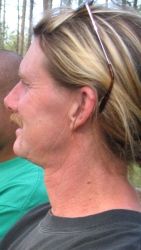 In
closing, Spirit and I wish to say thank you,
Meg-witch, Wado, to all the Sacred Runners
and Walkers and support teams, and to the
Choctaw Nation, Yakoki, for their endless
hospitality and endearing kindness. We love
each and every one of you, our hearts will
be with you every step as you go to complete
your honorable and Sacred Journey. A-ho,
Mitake Oyesin, Nemaste’, our family
now.
In
closing, Spirit and I wish to say thank you,
Meg-witch, Wado, to all the Sacred Runners
and Walkers and support teams, and to the
Choctaw Nation, Yakoki, for their endless
hospitality and endearing kindness. We love
each and every one of you, our hearts will
be with you every step as you go to complete
your honorable and Sacred Journey. A-ho,
Mitake Oyesin, Nemaste’, our family
now.
Robert Richardson (Tree)
Bull Shoals, Arkansas
Top
Day
53 - Tuesday, April 4, 2006
Choctaw Nation, Philadelphia, Mississippi
Today's reflection is by Sacred Walker Kevin
Wyer, of Maine.
Sacred Run,
April '06, Choctaw Territory
by Kevin Wyer
Healing
aroma of smouldering sage & sweetgrass
calms our circle.
Our family unrelated by anything
other than
purpose Listens respectfully to all.
Wise words, wise words.
Experience confirms the truth of
Nowa Cumig, All
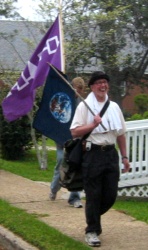 Life
is Sacred. Life
is Sacred.
So simple, so simple.
We run to heal our Earth Mother.
We walk for the Ancestors.
We run for Tomorrow.
We walk for the Little Ones.
Kevin
Wyer
Maine |
About
the Mississippi Choctaw People
..from the Choctaw welcome page, by Tribal
Chief Phillip Martin
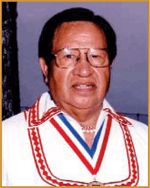 As
Choctaw people we have lived in present-day
Mississippi and parts of Louisiana
and Alabama since the times before
history was even recorded. Today the
Mississippi Band of Choctaw Indians
remains the only federally recognized
American Indian tribe living within
the State of Mississippi. Tribal enrolled
membership currently stands at more
than 9,100 individuals, all of whom
have at least a 50% quantum degree
of Choctaw blood. Also, about 85% of
Tribal members speak Choctaw
as their first language, and English
as a second language. As
Choctaw people we have lived in present-day
Mississippi and parts of Louisiana
and Alabama since the times before
history was even recorded. Today the
Mississippi Band of Choctaw Indians
remains the only federally recognized
American Indian tribe living within
the State of Mississippi. Tribal enrolled
membership currently stands at more
than 9,100 individuals, all of whom
have at least a 50% quantum degree
of Choctaw blood. Also, about 85% of
Tribal members speak Choctaw
as their first language, and English
as a second language.
The Choctaw Indian Reservation contains
some 35,000 acres of Tribal lands situated
in ten different Mississippi counties.
This land is held in trust for the
benefit of the Choctaw Tribe by the
federal government. The Tribe has seven
officially recognized Choctaw Indian
communities, and also the Crystal Ridge
community. The names of these sites
are Pearl River, Red Water, Bogue Chitto,
Standing Pine, Tucker, Conehatta, and
Bogue Homa. Pearl River, located
in Neshoba County, is the largest Choctaw
Indian community, and is the site of
Tribal government headquarters, as
well as Pearl River Resort.
The Tribal governmental structure has
been in place since 1945. In that year,
a Tribal constitution was ratified,
and a representative, democratic form
of government was established, with
equal representation among all Choctaw
communities....
Activities that Mississippi Choctaw
people enjoy are numerous, and include
generations-old Choctaw cultural events,
as well as modern activities of everyday
life and work. Cultural art forms that
Choctaws have been practicing for many
generations include weaving baskets by
hand from Mississippi swamp cane, handmaking beadwork of
many kinds, cultural
dancing, playing stickball,
sewing Choctaw
clothing, and cooking traditional
Choctaw foods....
Other activities include operating
a stable and complex Tribal
government, the largest unified
Indian K-12 school
system in the U.S., comprehensive
Tribal health
care programs, forestry, agricultural,
and natural resource programs, Tribal
gaming, entertainment, and resort operations,
and the manufacture of wiring harness
systems and audio speaker systems for
Ford Motor Company and the Chrysler
Corporation, among others. The Tribe
also hand-finishes greeting cards of
all kinds for the American Greeting
Corporation. Hightech industry located
on the Reservation includes Choctaw
Geo-Imaging Enterprise and joint projects
with the National Aeronautics and Space
Administration. These are just a few
examples of the successful business
enterprises in which the Tribe is involved.
Special occasions include the annual
Choctaw Indian Fair that is held each
July on the Choctaw Indian Reservation.
Spring festivals are also held in each
of the Choctaw communities. Thanksgiving
brings the annual Choctaw Thanksgiving
Feast. All of these events give Tribal
members an opportunity to gather as
a Choctaw community and celebrate the
Tribe's way of life, including all
Choctaw traditions as described above.
Foods that Choctaws have enjoyed for
many generations are fry bread, hominy,
and banaha, among others.
Chief Phillip
Martin
for more, see www.choctaw.org |
Top
Day
54 - Wednesday, April 5, 2006
Philadelphia, Mississippi to Summertown,
TN
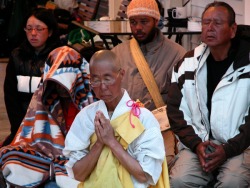 Today
is a HUGE travel day! 269 miles from
Philadelphia, Mississippi, all the way to
Summertown, Tennessee. Originally, our plan
was to travel only 120 miles to
Tupelo, Mississippi today. But the Tupelo
church that originally agreed to house us
cancelled. Someone or some group at the church
decided they didn't want our beautiful diversity
of faiths in their house of worship. Sacred
Runners' and Walkers' spiritual paths include
Native American, Buddhist, Shinto, Christian
and "other," and every stop includes
ceremonies with a variety of these elements.
Today
is a HUGE travel day! 269 miles from
Philadelphia, Mississippi, all the way to
Summertown, Tennessee. Originally, our plan
was to travel only 120 miles to
Tupelo, Mississippi today. But the Tupelo
church that originally agreed to house us
cancelled. Someone or some group at the church
decided they didn't want our beautiful diversity
of faiths in their house of worship. Sacred
Runners' and Walkers' spiritual paths include
Native American, Buddhist, Shinto, Christian
and "other," and every stop includes
ceremonies with a variety of these elements.
Here's how the 269 miles will be covered:
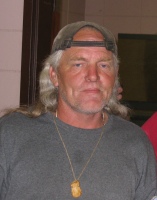 Les
Burris already covered the first 40 miles
yesterday. Les had a 53rd birthday last
week, and so he set out yesterday (a rest
day for the rest of us), intending to run
his age in miles. It is an amazing feat
of endurance that he made it for 40 miles!
Anyway, those first 40 were already run,
so we only need to cover 229 miles today.
The Sacred Walkers motored out and began
their 15 mile walk at the 40-mile mark.
Les
Burris already covered the first 40 miles
yesterday. Les had a 53rd birthday last
week, and so he set out yesterday (a rest
day for the rest of us), intending to run
his age in miles. It is an amazing feat
of endurance that he made it for 40 miles!
Anyway, those first 40 were already run,
so we only need to cover 229 miles today.
The Sacred Walkers motored out and began
their 15 mile walk at the 40-mile mark.- Runners would normally run the remaining
miles (269 miles, minus Les' 40, minus
the Runners' 15 = 214 miles for the runners).
- But we have an extra unplanned rest day
in Summertown, so we are planning to finish
as many miles as we can today, and backtrack
to run the rest tomorrow. This will help
solve two additional problems: a few of
us have a terrible cough and fever, and
several have knees or legs that are "out
of commission." We are determined
and we are strong -- we WILL make it to
Washington, D.C. But we need a lot
of prayers - thanks!
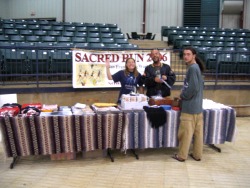 We've
had a lot of personnel changes lately. Rejoining
Sacred Run are Jerry Cunningham, and Julie
and Charlie Hernandez. New arrivals include
Bob Torres, Billy TurtleWarrior, Kevin Wyer
and Jon Blickenstaff. Leaving for home and
other destinations are George Ray, Jeremy
Nez, Minoh Banks, Tuffy Isham, Bill Arena,
Linda Rose, and Dennis Running Hawk Shirley.
Dennis Banks is traveling separately in New
Mexico for a few days, speaking and raising
funds for Sacred Run. In his absence, Dennis
asked Larry Bringing Good to convene our
ceremonial circles and give us leadership
and guidance. Everything feels new again
in this our eighth week together - who are
we? No matter who, the message is the heartbeat,
and the heartbeat is the same: All life
is Sacred.
We've
had a lot of personnel changes lately. Rejoining
Sacred Run are Jerry Cunningham, and Julie
and Charlie Hernandez. New arrivals include
Bob Torres, Billy TurtleWarrior, Kevin Wyer
and Jon Blickenstaff. Leaving for home and
other destinations are George Ray, Jeremy
Nez, Minoh Banks, Tuffy Isham, Bill Arena,
Linda Rose, and Dennis Running Hawk Shirley.
Dennis Banks is traveling separately in New
Mexico for a few days, speaking and raising
funds for Sacred Run. In his absence, Dennis
asked Larry Bringing Good to convene our
ceremonial circles and give us leadership
and guidance. Everything feels new again
in this our eighth week together - who are
we? No matter who, the message is the heartbeat,
and the heartbeat is the same: All life
is Sacred.
Tonight we arrive at The
Farm, in Summertown, Tennessee.
Here's a snapshot of The Farm from
A Short History
of The Farm, by Michael
Traugot
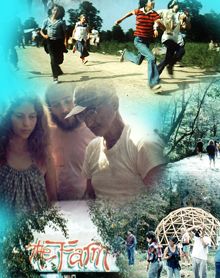 ...the
largest hippie commune in North America,
peaking out at around 1500 people in
1980, before reducing to its current
population of about 200. The Farm pioneered
in soy-based vegetarian diet, midwifery
and home birth, anti-nuclear activism
and alternative energy, grass roots
overseas relief and development work,
and communal living. Around 4,000 people
were official, signed-on members of
the Farm at one time or another in
its history, and there were over 100,000
overnight visitors to the community
during its first ten years. ...the
largest hippie commune in North America,
peaking out at around 1500 people in
1980, before reducing to its current
population of about 200. The Farm pioneered
in soy-based vegetarian diet, midwifery
and home birth, anti-nuclear activism
and alternative energy, grass roots
overseas relief and development work,
and communal living. Around 4,000 people
were official, signed-on members of
the Farm at one time or another in
its history, and there were over 100,000
overnight visitors to the community
during its first ten years.
...still a thriving community with
many businesses and projects designed
to help the planet. Plenty,
the Farm's non-profit relief and development
organization, is still quite active
and widely respected in development
circles. Children who were born and
raised on the Farm are now working,
traveling or in college, and a few
have started their own families. The
Farm is part of a growing network of
people and communities world-wide who
are working to solve the same basic
problems that the initiators of the
community set out to solve 24 years
ago. |
Top
Day
55 - Thursday, April 6, 2006
Summertown, Tennessee
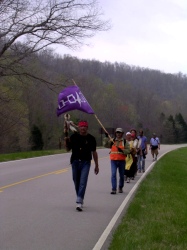 Yesterday's
journey on the Natchez Trace Parkway was
gorgeous! The Trace is a 440 mile long National
Park, following the traditional route of
the Natchez, Chickasaw and Choctaw people.
It begins in Natchez, in southern Mississippi,
and runs diagonally the entire length of
Mississippi, across the northwest corner
of Alabama, and all the way to the outskirts
of Nashville, Tennessee, where we are going
tomorrow. We got on the Trace at around mile
204 and stayed on it for 166 miles of peaceful
wooded roadway. No towns, no stores, no gas
stations - just parkland! The dogwoods are
blooming among hardwoods that are just waking
up, sunlight streamed through to welcome
us, and the trip was absolutely delightful.
We passed through a large number of important
historical and cultural places, including
these sacred sites: Bynum Mounds, Owl Creek
Mounds, Pharr Mounds, and Bear Creek Mound.
The bridge over the Tennessee River (in Alabama)
was breathtaking, wide and beautiful.
Yesterday's
journey on the Natchez Trace Parkway was
gorgeous! The Trace is a 440 mile long National
Park, following the traditional route of
the Natchez, Chickasaw and Choctaw people.
It begins in Natchez, in southern Mississippi,
and runs diagonally the entire length of
Mississippi, across the northwest corner
of Alabama, and all the way to the outskirts
of Nashville, Tennessee, where we are going
tomorrow. We got on the Trace at around mile
204 and stayed on it for 166 miles of peaceful
wooded roadway. No towns, no stores, no gas
stations - just parkland! The dogwoods are
blooming among hardwoods that are just waking
up, sunlight streamed through to welcome
us, and the trip was absolutely delightful.
We passed through a large number of important
historical and cultural places, including
these sacred sites: Bynum Mounds, Owl Creek
Mounds, Pharr Mounds, and Bear Creek Mound.
The bridge over the Tennessee River (in Alabama)
was breathtaking, wide and beautiful.
We arrived at The
Farm in Summertown yesterday afternoon
and evening.
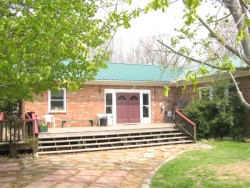 Located
on 3 square miles in south central Tennessee,
The Farm is home to approximately 200
persons today. Located
on 3 square miles in south central Tennessee,
The Farm is home to approximately 200
persons today.
Founded in 1971 with a spiritual commitment
to simple living and self-reliance,
The Farm has pioneered a wide range
of social and physical technologies
appropriate to low-cost, high satisfaction
community living.
The community offers examples of right
livelihood cottage industries, solar
building design, permaculture, micro-enterprise,
mushroom cultivation, composting and
gardening, and regenerative hardwood
forest management.
from The Farm's
website, www.thefarm.org/visit.html |
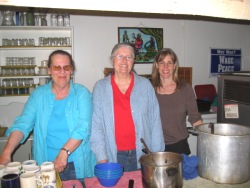 Many
thanks to our hosts, the residents of The
Farm. We were welcomed with a wonderful healthy
feast of chicken noodle soup, tofu noodle
soup, salad, fresh fruit and two kinds of
cake, prepared for us by Sharon Wells, Jean
Madrid, Eleanor Graf, Roberta Kachinsky and
Ramona Christopherson.
Many
thanks to our hosts, the residents of The
Farm. We were welcomed with a wonderful healthy
feast of chicken noodle soup, tofu noodle
soup, salad, fresh fruit and two kinds of
cake, prepared for us by Sharon Wells, Jean
Madrid, Eleanor Graf, Roberta Kachinsky and
Ramona Christopherson.
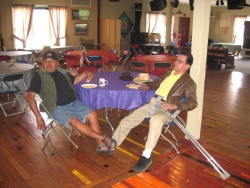 In
our Gathering Circle before dinner, we were
warmly greeted by an Elder of Sacred Run
and The Farm, Mark Madrid. Mark is Muskogee
Creek, and was Medical Director on the first
Sacred Run, "Longest Walk" in 1978.
He shared stories with us about the many
ways he and other members of The Farm have
worked with and for AIM and other Native
People throughout the Americas. Plenty,
The Farm's non-profit, tax-deductible charitable
organization, has been instrumental in this
work.
In
our Gathering Circle before dinner, we were
warmly greeted by an Elder of Sacred Run
and The Farm, Mark Madrid. Mark is Muskogee
Creek, and was Medical Director on the first
Sacred Run, "Longest Walk" in 1978.
He shared stories with us about the many
ways he and other members of The Farm have
worked with and for AIM and other Native
People throughout the Americas. Plenty,
The Farm's non-profit, tax-deductible charitable
organization, has been instrumental in this
work.
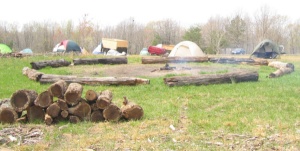 Today,
our Sacred Runners and Walkers are out on
the roads around Summertown, dodging a few
raindrops, finishing up the miles from yesterday's
olympic 269-mile unfinished run. One more
night camping here at The Farm, and then
we are off again, to Nashville. If you are
anywhere nearby, plan to attend a Sacred
Run concert at Brewsters in Lebanon, Tennessee,
about 20 miles east of Nashville, at 7pm
on Saturday night, April 8.
Today,
our Sacred Runners and Walkers are out on
the roads around Summertown, dodging a few
raindrops, finishing up the miles from yesterday's
olympic 269-mile unfinished run. One more
night camping here at The Farm, and then
we are off again, to Nashville. If you are
anywhere nearby, plan to attend a Sacred
Run concert at Brewsters in Lebanon, Tennessee,
about 20 miles east of Nashville, at 7pm
on Saturday night, April 8.
And if you are in the area, you might also
want to plan ahead for Sunday night, April
8, at 6:30pm, when there will be a Sacred
Run concert at Bissell Park, in Oak Ridge,
Tennessee, about 20 miles west of Knoxville.
Everyone welcome!
Top
Day
56 - Friday, April 7, 2006
Summertown, Tennessee to Nashville, Tennessee
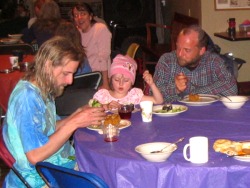 We
said farewell to the good folks at The Farm
in Summertown, Tennessee last night with
a potluck dinner, a slide show by Doug Stevenson,
and a late circle around the campfire. Doug's
slide show began with a history of the hippie
caravan of 1971, beginning in San Francisco
and ending in New York City, and the subsequent
founding of The Farm. He then told the history
of The Farm, including a beautiful series
of Mark Madrid's photos
We
said farewell to the good folks at The Farm
in Summertown, Tennessee last night with
a potluck dinner, a slide show by Doug Stevenson,
and a late circle around the campfire. Doug's
slide show began with a history of the hippie
caravan of 1971, beginning in San Francisco
and ending in New York City, and the subsequent
founding of The Farm. He then told the history
of The Farm, including a beautiful series
of Mark Madrid's photos 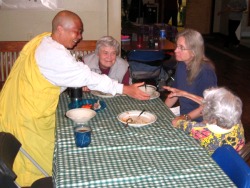 from
The Longest Walk (The first Sacred Run, 1978).
I was amazed at how much good work the residents
of The Farm have undertaken, not only for
themselves, but for others in the local,
national and international communities. I'd
have enjoyed more time to ask them how they
did it, how they managed to get so organized,
how they dealt with decision-making, leadership,
aging and community-building, among other
things. Rich in history and full of hope,
The Farm was a great stop. We won't forget
our new friends there.
from
The Longest Walk (The first Sacred Run, 1978).
I was amazed at how much good work the residents
of The Farm have undertaken, not only for
themselves, but for others in the local,
national and international communities. I'd
have enjoyed more time to ask them how they
did it, how they managed to get so organized,
how they dealt with decision-making, leadership,
aging and community-building, among other
things. Rich in history and full of hope,
The Farm was a great stop. We won't forget
our new friends there.
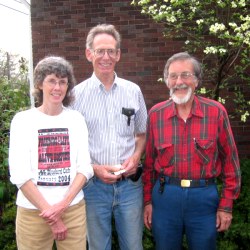 Today
we traveled the Natchez Trace again, and
finished on state roads and city streets
right into Nashville. Most of us - and our
gear - was safely inside the Nashville
Friends Meeting House before the downpour
of rain and the heavy thrashing of hail.
As I write this, some of our runners have
still not arrived, and I hope they weren't
on the road running in the hailstorm. I'll
let you know when I find out. (Later:
Feather got soaked, and loved it; and no
runners got hit by the hail.) There
are tornado warnings in our area now, and
several dark weather fronts have passed over.
We will say prayers in
Today
we traveled the Natchez Trace again, and
finished on state roads and city streets
right into Nashville. Most of us - and our
gear - was safely inside the Nashville
Friends Meeting House before the downpour
of rain and the heavy thrashing of hail.
As I write this, some of our runners have
still not arrived, and I hope they weren't
on the road running in the hailstorm. I'll
let you know when I find out. (Later:
Feather got soaked, and loved it; and no
runners got hit by the hail.) There
are tornado warnings in our area now, and
several dark weather fronts have passed over.
We will say prayers in 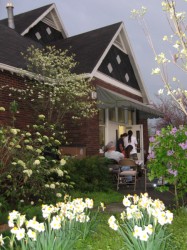 Closing
Circle tonight for any who have come to harm
by the fierce blind power of Mother Nature.
Closing
Circle tonight for any who have come to harm
by the fierce blind power of Mother Nature.
I'll repeat the invitations I gave in yesterday's
reflection: If you are anywhere nearby, plan
to attend on Saturday night, April 8 at 7pm,
a Sacred
Run concert at Brewsters in Lebanon, Tennessee,
about 20 miles east of Nashville.
And if you are in the area, you might also
want to plan ahead for Sunday night, April
8, at 6:30pm, when there will be a Sacred
Run concert at Bissell Park, in Oak Ridge,
Tennessee, about 20 miles west of Knoxville.
Everyone welcome!
Top
Day
57 - Saturday, April 8, 2006
Nashville to Knoxville, Tennessee
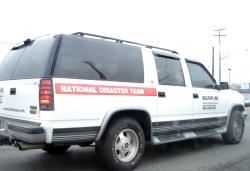 On
my way out of Nashville this morning, I passed
by a caravan of 8 National Disaster Team
vehicles. The smaller ones looked like this.
Wild
On
my way out of Nashville this morning, I passed
by a caravan of 8 National Disaster Team
vehicles. The smaller ones looked like this.
Wild  and
ferocious storms cut a destructive path in
northern middle Tennessee yesterday, with
over 30 tornado touch-downs. Not far from
our overnight stay in Nashville, 11 people
lost their lives. Homes, churches, schools
and other buildings were ruined or severely
damaged, farm animals and pets, trees and
crops -- everything took a beating.
and
ferocious storms cut a destructive path in
northern middle Tennessee yesterday, with
over 30 tornado touch-downs. Not far from
our overnight stay in Nashville, 11 people
lost their lives. Homes, churches, schools
and other buildings were ruined or severely
damaged, farm animals and pets, trees and
crops -- everything took a beating.
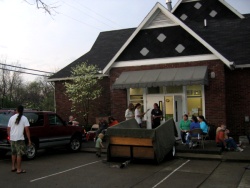 Our
own experience of a pounding hail storm at
the Friends Meeting House in Nashville pales
in comparison of course. Our sore knees,
our flus and our achy muscles, our longing
for home and loved ones... none of it compares.
Just like when we walked through the hurricane
territories, our hearts ache in a mysterious
and grace-filled way: we feel our connectedness
with those who suffer as an inner anguish
like that which families feel when there
is grieving to do. Shock, disbelief, sorrow
and pain, and then a strengthened resolve
to go on, to persist, to renew and to rebuild.
Life itself is like a long-distance run.
Our
own experience of a pounding hail storm at
the Friends Meeting House in Nashville pales
in comparison of course. Our sore knees,
our flus and our achy muscles, our longing
for home and loved ones... none of it compares.
Just like when we walked through the hurricane
territories, our hearts ache in a mysterious
and grace-filled way: we feel our connectedness
with those who suffer as an inner anguish
like that which families feel when there
is grieving to do. Shock, disbelief, sorrow
and pain, and then a strengthened resolve
to go on, to persist, to renew and to rebuild.
Life itself is like a long-distance run.
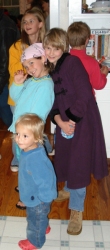 Time
to get out your calculators! A slightly twisted
math lesson is necessary to understand today's
Sacred Walk and Run. We covered 193 miles,
but only walked and ran 165. Our feet carried
us from Nashville to Oak Ridge, Tennessee.
We motored the remaining 28 miles, and we
will run that leg backwards tomorrow (Sunday,
April 9). It all works out beautifully, because
tomorrow we will hold a peace vigil at the
Y-12 Nuclear Research Facility in Oak Ridge,
and then we'll attend a Sacred Run Concert
in nearby Bissell Park at 6:30.
Time
to get out your calculators! A slightly twisted
math lesson is necessary to understand today's
Sacred Walk and Run. We covered 193 miles,
but only walked and ran 165. Our feet carried
us from Nashville to Oak Ridge, Tennessee.
We motored the remaining 28 miles, and we
will run that leg backwards tomorrow (Sunday,
April 9). It all works out beautifully, because
tomorrow we will hold a peace vigil at the
Y-12 Nuclear Research Facility in Oak Ridge,
and then we'll attend a Sacred Run Concert
in nearby Bissell Park at 6:30.
The Sacred Run group is split today and
tonight. Nine of us stayed behind in Nashville
for a Sacred Run Concert there. I hope to
get a picture or two of that event for you,
but I'm with the main group in Knoxville.
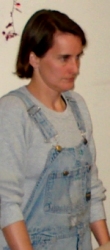 Our
hosts tonight are Lissa McLeod and Ralph
Hutchison of Knoxville, and their two children,
Sarah Margaret Hutchison and Emma McLeod.
I should also mention the sweet ol cats,
Sojourner and two black and white ones, and
Our
hosts tonight are Lissa McLeod and Ralph
Hutchison of Knoxville, and their two children,
Sarah Margaret Hutchison and Emma McLeod.
I should also mention the sweet ol cats,
Sojourner and two black and white ones, and 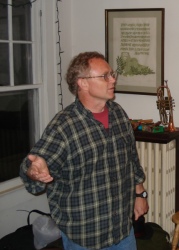 a
very old dog. Lissa and Ralph, along with
friends who are part of their community prepared
a great feast of soup, salad, lasagne, bread,
oranges and an apple crisp that was probably
even better than the one I make! Everyone
pitched in after dinner to clean up, and
we are currently gathered around in various
rooms in their huge old home. Ralph was telling
the story of their dream of housing an extended
community in the house, and how that didn't
come to pass exactly. But they do host large
groups here, and that's when the place feels "right." It
sure is "right" at this moment
- crawling with people and cats, buzzing
with multiple conversations, filled with
the incense smell of Jun-san's healing, and
pulsing with the sound of the Elvis cd Nathan
Chasing Horses picked up in Tupelo! What
a mix of cultures! Maybe we're in heaven!
a
very old dog. Lissa and Ralph, along with
friends who are part of their community prepared
a great feast of soup, salad, lasagne, bread,
oranges and an apple crisp that was probably
even better than the one I make! Everyone
pitched in after dinner to clean up, and
we are currently gathered around in various
rooms in their huge old home. Ralph was telling
the story of their dream of housing an extended
community in the house, and how that didn't
come to pass exactly. But they do host large
groups here, and that's when the place feels "right." It
sure is "right" at this moment
- crawling with people and cats, buzzing
with multiple conversations, filled with
the incense smell of Jun-san's healing, and
pulsing with the sound of the Elvis cd Nathan
Chasing Horses picked up in Tupelo! What
a mix of cultures! Maybe we're in heaven!
